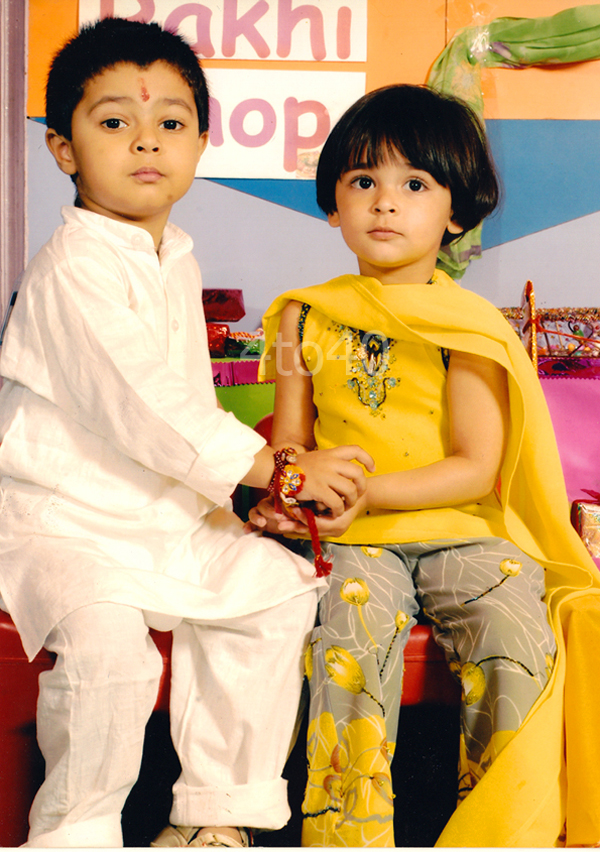Ayodhya Nath Kerni
Raksha Bandhan is one of the most joyful festivals celebrated with great fervor In India. It reminds one of the solemn pledge towards the person who ties the colourful thread. The festival falls on full moon day of Shravan lunar calander month. Sisters tie rakhi on the wrists of brothers on this auspicious day and pray Almighty for their long life.
Preparation of Festival
A thali is arranged by keeping the articles like flowers, vermilion powder, rice grains, sweets, fruits and rakhi etc.
A tika is applied on the forehead of brother and a bracelet like woven thread available in market in assorted colours and designs as rakhi is tied on the wrist.
All these rituals take place amid the chanting of the following mantras :
“Suraj shakhan chhodian, Mooli chhodia beej
Behen ne rakhi bandhi / Bhai tu chir jug jee”,
Which means “The sun radiates its sunlight, the radish spreads its seeds,
I tie the rakhi to you O brother and wish that may you live long.”
After her prayer for a long life for her brother, she says that she is tie the ever-protective Raksha to her brother’s wrist and chants:
“Yena baddho Balee raajaa daanavendro mahaabalah
tena twaam anubadhnaami rakshe maa chala maa chala”
This means,” I tie you the rakhi that was tied to king Bali, the king of Demons,
O Rakhi I pray that you never falter in protecting your devotee.
Normally sisters do visit the houses of brothers and tie rakhis. Rakhis are tied not only by real brothers and real sisters but are also being exchanged between other people as a mark of friendship and social harmony. Rakhi was also tied in the past by village purohits (priests) to village yajmans in Jammu region who in turn offered them money and other articles.
Legends
There are many legendary accounts regarding Raksha Bandhan. Once Yamuna tied coloured thread to Yama, the lord of death. Yama was moved by this gesture and granted a boon of immortality on this day. Since those times there is apprehension that any brother who is tied rakhi on raksha bandhan day and offers to protect sister would also receive longevity in accordance with Yama boon.
Once there was a war between Devtas and Aasuras for twelve years. Devtas could not win the war. Dev guru Brihaspati insisted to stop the war. Inderani said on hearing all this that she will tie a rakhi to Indera next day being Shravan Purnima and devtas would win the war. Consequently war was won by the devtas.
Once lord Krishna while handling sugar cane got his finger cut. There was bleeding from his injured finger. Droupadi standing near by tore off a part of her sari and bandaged his bleeding finger. In return for this act of sympathy Krishna promised to protect her in the time of distress. That was how her sari became endless on the day she was disturbed in full public by Kauravas.
The other legend states that as a part of a promise lord Vishnu has been protecting his devotee and demon king Bali, disguising himself as a door man.
Luxmi , goddess of wealth and prosperity ,disguising herself as a woman seeking shelter to live in since her husband has been away, Bali gave her shelter in the palace. She tied rakhi on Bali’s wrist and wished his happiness and prosperity. Bali asked her desire and promised to fulfill it. She requested Bali to release his gate keeper. Bali agreed and kept his promise. Both were released by Bali. Meanwhile their identity was disclosed and lord Vishnu promised Bali to be with him for four months each year.
Historical Account
The other evidence about Raksha Bandhan exists in Indian History. Rana Sangram Singh better known in history as Rana Sanga was an undaunted warrior who defeated the kings of Delhi, Malwa and Gujrat established his fame as mighty leader. After his death his wife Karnavati who originally belonged to Bundi ruled Mewar temporarily in the name of her son Vikramajit. Bahadur Shah the ruler of Gujrat was young and ambitious prince who cherished the desire to seize the kingdom of Delhi. He launched second massive attack on Mewar with its capital at Chittor. Karnavati sent a rakhi to Humayun calling him brother and request for help. She also consolidated the nobles to face Bahadur Shah.
Humayun was in the middle of another military compaign in Bengal when he received rakhi and call for help. Humayun marched towards Mewar with his army but unfortunately reached late and by that time Karnavati committed self immolation to protect herself from indignity of falling in hands of Bahadur Shah. Humayun defeated Bahadur Shah and restored the kingdom to Kanrnavati’s son Vikramajit. This is the most glaring example of Raksha Bandhan. How a muslim emperor was inspired with a pious rakhi of a Hindu lady. He kept aside his strategical warfare plans rather abandoned his military preferences and reached for the rescue of Karnavati. She had two sons Vikramajit and Udey Sinh. The great warrior Rana Pratap happens to be son of Udey Sinh and grand son of Karnavati.
The custom to tie rakhi began from the historical ages. The message behind this is that brothers should become prosper and should protect the sisters at the time of distress and need. The sisters should pray for welfare of brothers. The sisters and brothers may join together to pray Almighty for the strength to serve and protect the nation.
Trending Now
E-Paper


